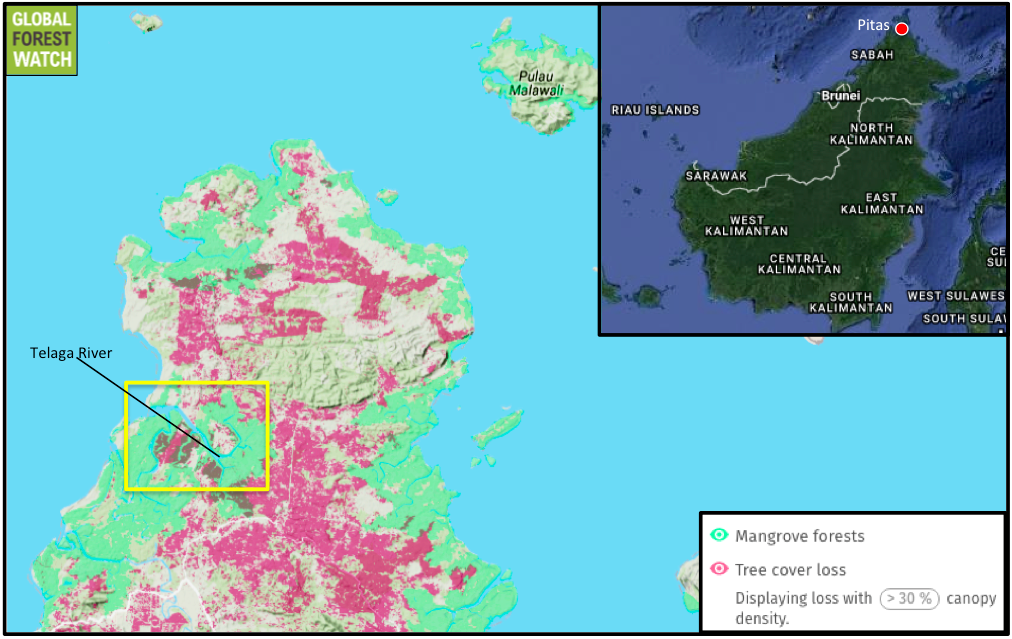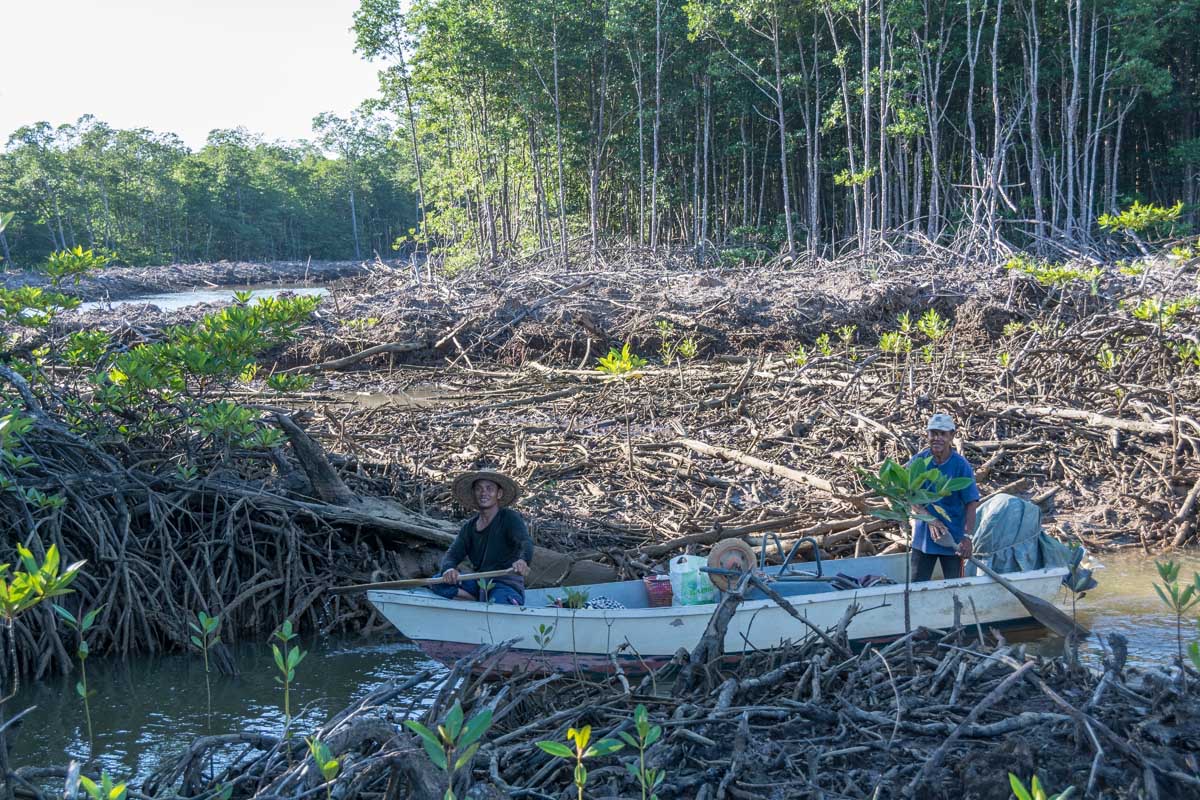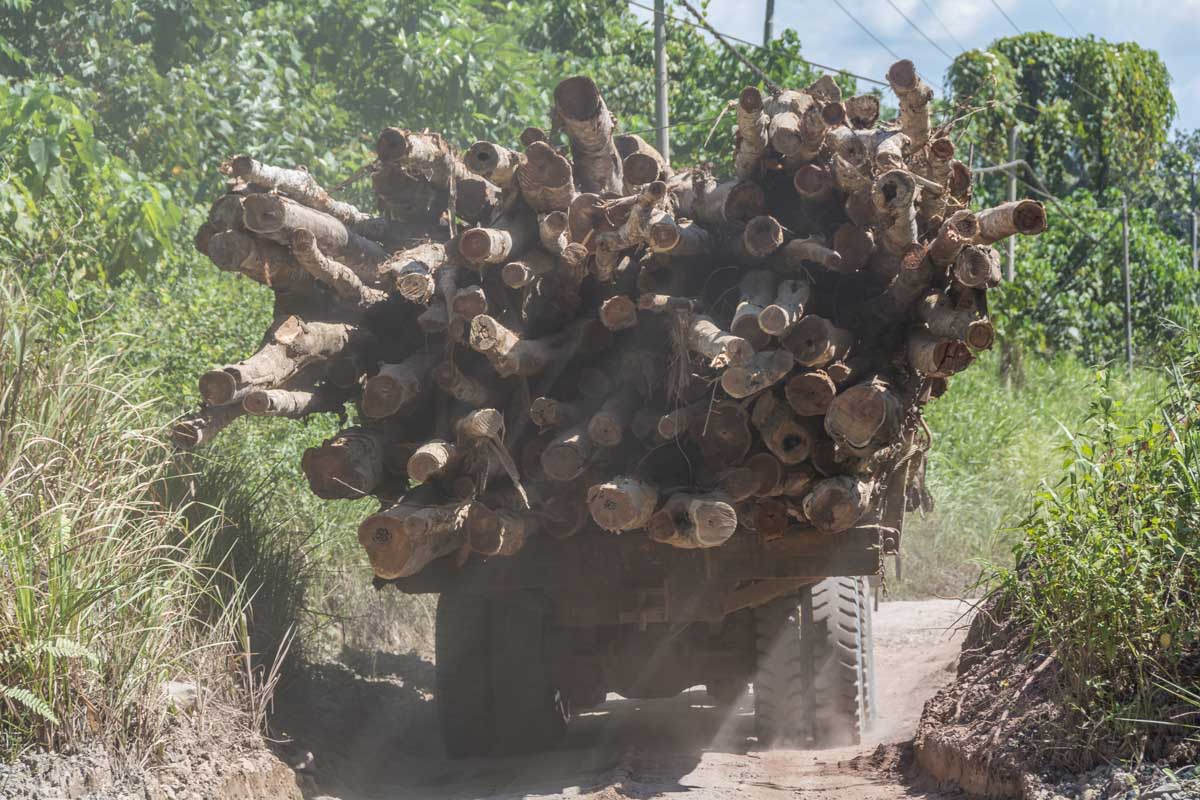- A development plan establishing shrimp farms and timber plantations begun purportedly to reduce poverty in northern Sabah, Malaysia, has attracted criticism from local communities and NGOs, which say the project is ignoring communities’ land rights.
- Satellite imagery shows the clearing of large tracts of mangrove forest for shrimp farms. Critics of the development say this is depriving forest-dependent local communities of their livelihoods as well as threatening mangrove wildlife.
- Several communities have banded together and are together petitioning the government to officially recognize their rights to the remaining mangroves and prevent further clearing for development.
This forested, hilly area slopes down to the coast along the Telaga River, through ancient mangrove forest. But since the 1980s, it has been increasingly opened up by government-sanctioned development projects; more recently, in 2013, mangrove clearance has resumed for the commercial farming of shrimp (also referred to as prawns). This resurgence has brought the company Sunlight Inno Seafood Company Sdn Bhd, which is supported by the government, into conflict with local communities that depend on the mangroves for their livelihoods.


Farmer and fisherman Mastupang Bin Somoi, 52, from Kampung Sungai Eloi, is founder and Chairman of the G6 collective. In his gardens he grows vegetables, rice and a few rubber and oil palm trees. He shows me a handful of large shellfish he has gathered from the muddy riverbed at the nearby boat landing. He says the villagers in the area depend on a mix of farming, fishing and collecting non-timber forest products from the mangrove forest for their livelihoods.


“This sign says, ‘no encroachment’,” says Somoi, pointing to a sign tied to a tree. The signs have been placed by the communities to demarcate the perimeter of the mangrove forest claimed under their NCR. Around 2,300 acres have already been cleared under the project and this is set to expand next into an additional 1,000 acres, pending the outcome of an Environmental Impact Assessment (EIA) started in 2015.
Further along, Somoi points out a burial site he says is sacred to the communities. Soon the dense mangrove forest opens into a clearing of stark devastation with dead mangrove roots bleached silver by the tropical sun and the dark peat earth beneath torn into grooves by heavy equipment. Most of the forest has already been cleared and the communities are desperate to retain the remainder on which they depend for resources, as well as the other ecosystem services it provides.
The shrimp farms cut out of the mangrove forests are secured with two-meter-high solid metal fences backed with coils of razor wire to keep people out. One plot visited by Mongabay was an area about 400 meters (1,300 feet) across containing artificial ponds in which water was being circulated with turbine pumps; a handful of workers was on-site.

“There is no water connection so people save rainwater from their roofs and when that is gone have to pay for deliveries,” Thanda said. She explained that levels of poverty in Pitas are high compared with most of Sabah.
However, according to Thanda, the project has floundered due to mismanagement and a lack of processing, storage and transportation infrastructure.
“Look at their office – it’s new. That’s the prawn farm company. When I came in November it wasn’t there,” said Thanda, explaining how the project is proceeding despite initial deficiencies.
“The Sunlight company was supposed to open a plant in Pitas to process prawns and provide 3,000 jobs, but nothing is happening,” Thanda told Mongabay. She said local people are dismayed that foreign workers have been brought in, and that few of the jobs originally promised have materialized. Sunlight Inno Seafood Company Sdn Bhd did not respond to requests for comment.
The boat stops at a large stand of dead mangrove trees. The communities suspect they were poisoned because at the same time the trees died, “all the fish died” in the area, Thanda said. This area of mangroves was frequently used by local communities, and its destruction galvanized members from the G6 collective into action. In June 2015 they confronted workers clearing the area with heavy equipment.

According to Thanda, thirty staff from the G6 communities working in the shrimp farms were sacked within the following month. She suspects that this was punitive retaliation by the shrimp company for protesting further clearance.
The equipment was subsequently removed and the Environmental Protection Department responded that an EIA would now be conducted on the area to assess whether clearance should proceed. But despite beginning in 2015, the EIA is still pending. The G6 collective has since been active in denouncing the conduct of the EIA process and the project in general. Meanwhile, according to SEPA, in December 2015 the State Cabinet approved clearance of a further 3,000 hectares of mangrove forest in the region.

Clearance of the forest is nothing new to the communities. Bihahon Rumindon, 67, from Kampong Boluuh village (which is a member of the G6 collective), has been fighting for recognition of his land title for years. He says that while he was awarded the land by the Sabah Forestry Development Authority (SAFODA) in 1971, SAFODA did not follow though on the allocation commitment and instead used it for a local acacia plantation project now managed by Acacia Forest Industries Sdn Bhd (AFI). The company is currently structured as a 50:50 joint venture between SAFODA and the Hijauan Bengkoka Plantations Sdn Bhd (HASB) company and supported by SAFODA.

Requests for comment sent to AFI were unanswered by press time.
Rumindon explained that his people, the Rungus indigenous people, were originally nomadic. He and his neighbors agreed to settle on the land offered to them by SAFODA. He said the department offered 18 acres of land per family if they agreed to give up their nomadic tradition, settle there and clear the forest to cultivate crops.
“There was a survey conducted and stones put in the ground in 1974,” Rumindon explained, thumbing through a thick folder of correspondence with government officials.
According to Rumindon, in the late 1970s the community agreed to requests from the original acacia company, Hijuan Planters, to rent the land, because the company said it would clear it. Mongabay visited AFI’s loading dock where cranes load vast piles of acacia logs onto barges destined for pulp and paper mills.
“SAFODA says we are encroachers” said Rumindon, who despite his age is still struggling for a just outcome and says it was SAFODA that leased it to the company. Rumindon says the land was never returned. AFI, which took over operations more recently, retains occupation of the plantation area still under operation, and their claim appears to be supported by SAFODA.
“It took seven years to get hold of the [paper] plan,” Rumindon explained, unrolling a large detailed plan of community land from the land department. It appears to conflict with an earlier plan that clearly shows the plots allocated to community families.
“SAFODA began designing reforestation and settlement projects in Bengkoka in early 1979,” reads a translated version of SAFODA’s website. “Acacia mangium cultivation was started in 1981. This project is the only large-scale institutional farm dedicated to commercial purposes.” The site does not mention an earlier land agreement, and requests for comment sent by Mongabay to several senior SAFODA staff went unanswered.


Rapid clearance of natural eco-systems for development projects in Sabah is an ongoing issue of concern to conservationists, and the situation in Pitas is no exception. As forest is razed for development, already-threatened species may be placed at greater risk. Meanwhile, local communities may face the loss of the many valuable ecosystem services mangrove forests provide, such as fishing, foraging and water catchment.
So far, local indigenous groups say their appeals for official recognition of their rights over these lands have largely been ignored. Critics say government development plans remain firmly in favor of supporting big businesses, despite damaging environmental consequences.
by Rod Harbinson on 13 September 2017
Mongabay Series: Global Forest Reporting Network
FEEDBACK: Use this form to send a message to the editor of this post. If you want to post a public comment, you can do that at the bottom of the page.
Article published by Morgan Erickson-Davis












Đăng nhận xét